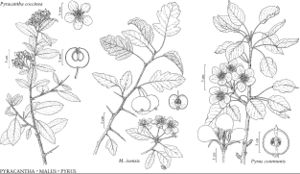Pyracantha
Fam. Nat. Syn. Monogr. 3: 104, 219. 1847.
| Taxon | Illustrator ⠉ | |
|---|---|---|
 | Pyracantha coccinea Malus ioensis Pyrus communis | Marjorie C. Leggitt Marjorie C. Leggitt Marjorie C. Leggitt |
Shrubs, spreading or partially reclining, 5–60 dm. Stems 1–3+, erect or divergent, straight or geniculate; bark grayish, thin, smooth, becoming slightly fissured; long and short-shoots present, leafy; thorns present (commonly on short-shoots); glabrous or tomentose. Leaves persistent or late-deciduous, cauline, fascicled on short-shoots, simple; stipules caducous, free, lanceolate, membranous, margins remotely serrate, glabrous or tomentose; petiole present; blade obovate, ovate, oblong-obovate, oblong, or elliptic to lanceolate or oblanceolate, 1–7 cm, leathery, margins flat or slightly revolute, serrulate, crenulate, or entire, venation pinnate, surfaces glabrous or sparsely hairy to densely tomentose when young, often glabrescent later. Inflorescences terminal, 6–40-flowered, flat-topped panicles, glabrous or tomentose; bracts present, caducous, lanceolate; bracteoles present. Pedicels present. Flowers: perianth and androecium epigynous, 3–10 (–12) mm diam.; hypanthium campanulate, 2–4 mm diam., exterior glabrous or densely tomentose; sepals 5, spreading, broadly elliptic or triangular; petals 5, spreading, white, usually suborbiculate, base slightly clawed; stamens 15–20, shorter than petals, filaments 2–4 mm; carpels 5, distinct, adnate to proximal 1/2 of hypanthium, externally glabrous or tomentose, styles terminal, distinct, about equal to stamens; ovules 2. Fruits pomes, red or orange-red, rarely yellow, globose, 3–8 mm diam., glabrate; flesh soft; hypanthium persistent; sepals persistent, erect or incurved; carpels woody; styles usually persistent. Pyrenes 5. x = 17.
Distribution
Introduced; Europe, Asia, also in Africa, Pacific Islands, Australia
Discussion
Species 10 (6 in the flora).
Morphologic studies align Pyracantha near Cotoneaster or Heteromeles (J. R. Rohrer et al. 1991; K. R. Robertson et al. 1991, 1992; C. S. Campbell et al. 2007). Molecular studies to date are inconclusive and have failed to provide strong or consistent support for these or alternative placements of Pyracantha (R. C. Evans and Campbell 2002; D. Potter et al. 2007; Campbell et al.). The difficulty in resolving the generic phylogeny of Maleae may be due in part to interfertility, lack of divergence, and reticulate evolution (Campbell et al.).
Species of Pyracantha are widely cultivated as ornamentals, and over 100 cultivars (D. R. Egolf and A. O. Andrick 1995) and hybrids are known. Of the ten species traditionally recognized, nine are native to China, some showing sufficient overlap of distribution and morphology that the taxonomy is not well defined. The plants as a group have been assigned in earlier treatments to the genera Cotoneaster, Crataegus, Mespilus, Sportella, and Timbalia Clos. Reports of additional naturalizing taxa could increase the number of our six sporadically naturalized species; validating specimens were not seen. Seedlings of naturalized Pyracantha most frequently appear in ruderal areas, along roads, forest edges, thickets, and in proximity to plantings. Spontaneous intermediates occasionally appear where cultivated species or hybrids grow in proximity, as no barrier to hybridization is apparent. The pomes are eaten by birds, most notably American robins (Turdus migratorius Linnaeus) and cedar waxwings (Bombycilla cedrorum Vieillot).
Selected References
None.
Lower Taxa
Key
| 1 | Leaf margins crenulate, crenulate-serrulate, or serrulate (at least 1/2 length of blades) | > 2 |
| 1 | Leaf margins usually entire, rarely remotely serrulate distally or with minute teeth near apices | > 4 |
| 2 | Leaf blades oblanceolate or obovate, apices obtuse, emarginate, or short-apiculate. | Pyracantha fortuneana |
| 2 | Leaf blades lanceolate, oblong, oblanceolate, ovate-lanceolate, elliptic, or ovate, apices usually acute or short-apiculate | > 3 |
| 3 | Young twigs gray-hairy, glabrescent later; hypanthia finely hairy. | Pyracantha coccinea |
| 3 | Young twigs brown-hairy, glabrescent later; hypanthia glabrous. | Pyracantha crenulata |
| 4 | Calyces and leaf abaxial surfaces persistently gray-tomentose. | Pyracantha angustifolia |
| 4 | Calyces and leaf abaxial surfaces brown- or yellowish brown-puberulent when young, glabrescent | > 5 |
| 5 | Leaf blades elliptic, oblong, or oblong-obovate (usually widest near middle), apices obtuse, apiculate, or aristate, abaxial surfaces glaucescent. | Pyracantha atalantioides |
| 5 | Leaf blades oblanceolate or narrowly obovate (usually widest distal to middle), apices usually truncate or retuse, abaxial surfaces pale green but not glaucescent. | Pyracantha koidzumii |
"thin" is not a number.